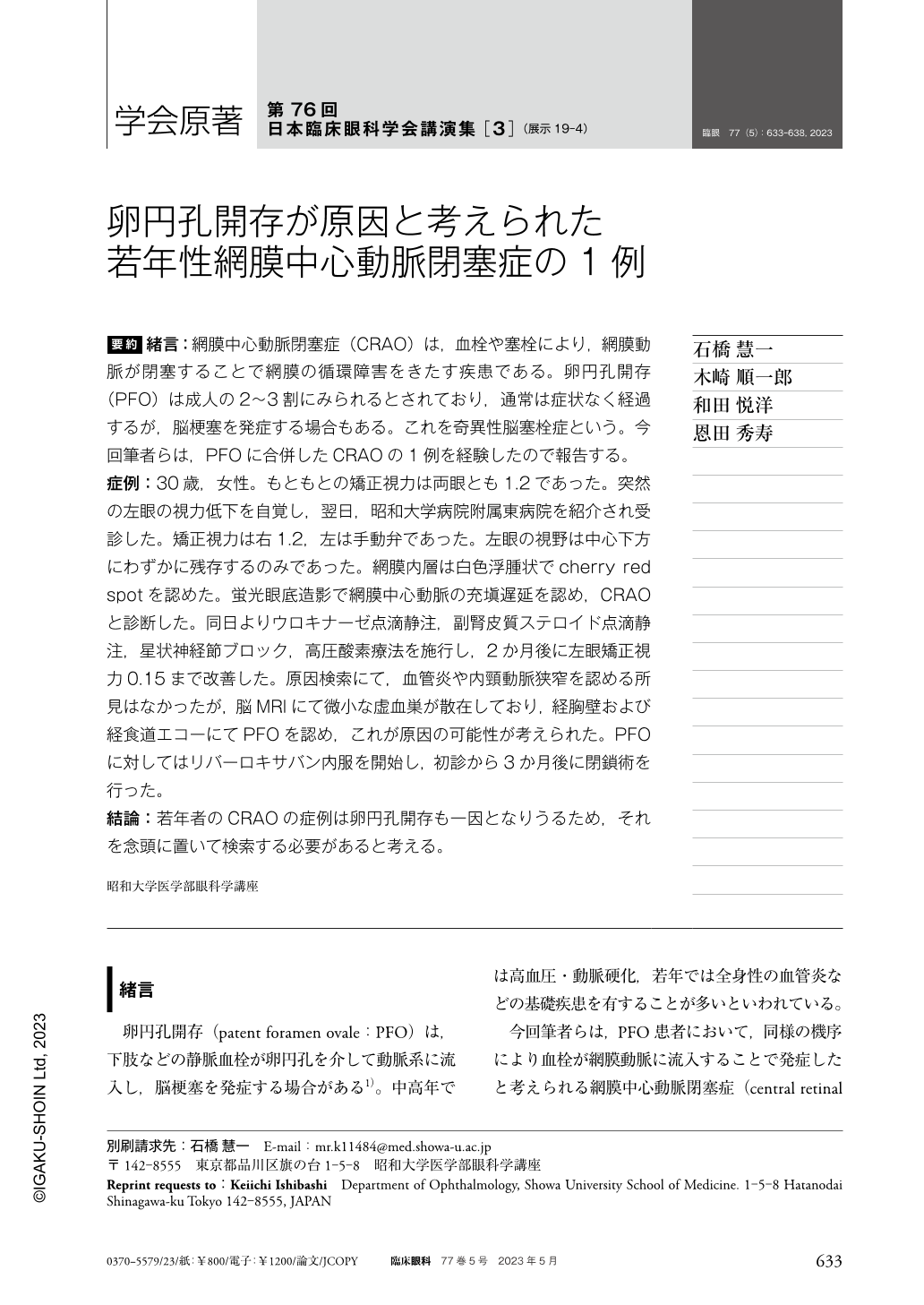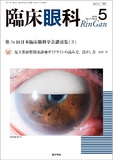Japanese
English
- 有料閲覧
- Abstract 文献概要
- 1ページ目 Look Inside
- 参考文献 Reference
要約 緒言:網膜中心動脈閉塞症(CRAO)は,血栓や塞栓により,網膜動脈が閉塞することで網膜の循環障害をきたす疾患である。卵円孔開存(PFO)は成人の2〜3割にみられるとされており,通常は症状なく経過するが,脳梗塞を発症する場合もある。これを奇異性脳塞栓症という。今回筆者らは,PFOに合併したCRAOの1例を経験したので報告する。
症例:30歳,女性。もともとの矯正視力は両眼とも1.2であった。突然の左眼の視力低下を自覚し,翌日,昭和大学病院附属東病院を紹介され受診した。矯正視力は右1.2,左は手動弁であった。左眼の視野は中心下方にわずかに残存するのみであった。網膜内層は白色浮腫状でcherry red spotを認めた。蛍光眼底造影で網膜中心動脈の充塡遅延を認め,CRAOと診断した。同日よりウロキナーゼ点滴静注,副腎皮質ステロイド点滴静注,星状神経節ブロック,高圧酸素療法を施行し,2か月後に左眼矯正視力0.15まで改善した。原因検索にて,血管炎や内頸動脈狭窄を認める所見はなかったが,脳MRIにて微小な虚血巣が散在しており,経胸壁および経食道エコーにてPFOを認め,これが原因の可能性が考えられた。PFOに対してはリバーロキサバン内服を開始し,初診から3か月後に閉鎖術を行った。
結論:若年者のCRAOの症例は卵円孔開存も一因となりうるため,それを念頭に置いて検索する必要があると考える。
Abstract Introduction:Central retinal artery occlusion(CRAO)is a disease in which the retinal artery is blocked by a blood clot or embolus, causing circulatory disorders in the retina. We experienced a case of CRAO combined with the patency of the foramen ovale.
Case:The patient was a 30-year-old woman. The original corrected visual acuity was 1.2 in both eyes. Aware of the sudden loss of vision, she presented to Showa University Hospital East Hospital the next day. The corrected visual acuity was 1.2 in the right eye, and the left eye was a manual valve. The field of view of the left eye remained only slightly below the center. The retina was white edematous and a cherry red spot was observed throughout. Fluorescent fundus angiography showed delayed filling of the retinal artery, and CRAO was diagnosed. On the same day, intravenous urokinase infusion, oral steroids, stellate ganglion block, and hyperbaric oxygen therapy were performed, and after 2 months, the corrected visual acuity of the left eye improved to 0.15. There were no findings of vasculitis or internal carotid artery stenosis, but brain magnetic resonance imaging showed scattered small ischemic foci, and transthoracic wall and transesophageal echo showed foramen ovale patency, which may be the cause. For the patency of the foramen ovale, oral Xarelto was started, and closure surgery was performed 3 months after the first visit. Foramen ovale patency is said to occur in 20-30% of adults, and usually occurs without symptoms, However it has been reported that cerebral infarction develops in 5-10% of cases.
Conclusion:Since patency of the foramen ovale can also play a role in CRAO cases in young people, it is important to consider its presentation.

Copyright © 2023, Igaku-Shoin Ltd. All rights reserved.


